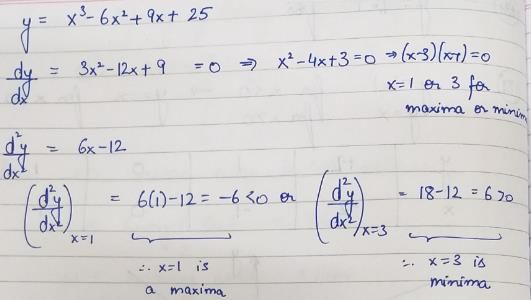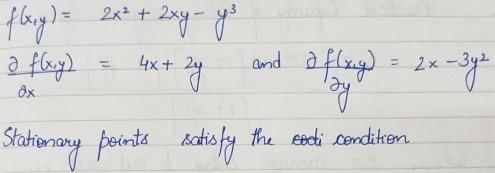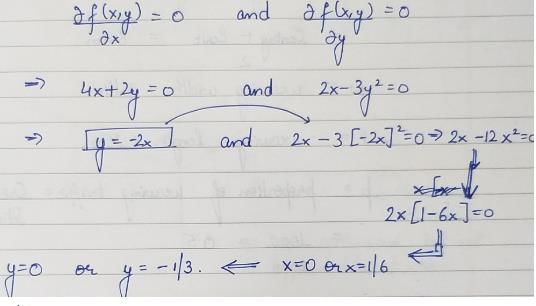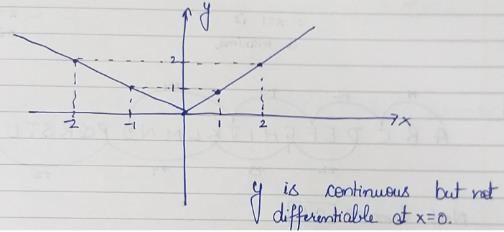All Exams >
Mechanical Engineering >
Engineering Mathematics for Mechanical Engineering >
All Questions
All questions of Calculus for Mechanical Engineering Exam
Minimum of the real valued function f(x) = (x-1)2/3 occurs at x equal to- a)- ∝
- b)0
- c)1
- d)∝
Correct answer is option 'C'. Can you explain this answer?
Minimum of the real valued function f(x) = (x-1)2/3 occurs at x equal to
a)
- ∝
b)
0
c)
1
d)
∝
|
|
Kunal Gupta answered |

As f(x) is square of hence its minimum value be 0 where at x = 1.
Consider the function f(x) = |x|3, where x is real... more. Then the function f(x) at x = 0 isa)Continuous but not differentiable
b)Once differentiable but not twice
c)Twice differentiable but not thrice
d)Thrice differentiable
Correct answer is option 'C'. Can you explain this answer?
|
|
Diya Mukherjee answered |
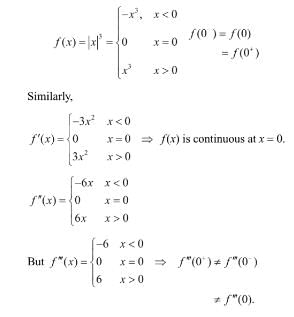
The minimum point of the function f(x) = (x2/3) – x is at - a) x = 1
- b)x = -1
- c) x = 0
- d)x = 1/√3
Correct answer is option 'A'. Can you explain this answer?
The minimum point of the function f(x) = (x2/3) – x is at
a)
x = 1
b)
x = -1
c)
x = 0
d)
x = 1/√3
|
|
Avinash Sharma answered |
Correct Answer :- a
Explanation : f(x) = (x^2/3) - x
f'(x) = 2/3(x-1/2) - 1
f"(x) = -1/3(x-3/2)
For critical points. f′(x)=0
=> 2/3(x-1/2) - 1 = 0
f has minimum value of x = 1

- a)∞
- b)2
- c)0
- d)1
Correct answer is option 'C'. Can you explain this answer?
a)
∞
b)
2
c)
0
d)
1
|
|
Yash Patel answered |
the squeeze theorem for this. Recall that sinx is only defined on −1≤sinx≤1. Therefore

How many points c∈[0, 16x] exist, such that f'(c) = 1- a)256
- b)512
- c)16
- d)0
Correct answer is option 'A'. Can you explain this answer?
How many points c∈[0, 16x] exist, such that f'(c) = 1
a)
256
b)
512
c)
16
d)
0

|
Pioneer Academy answered |
To find points such that f'(c) = 1
We need to check points on graph where slope remains the same (45 degrees)
In every interval of the form [(n – 1)π, nπ] we must have 2n – 1 points
Because sine curve there has frequency 2n and the graph is going to meet the graph y = x at 2n points.
Hence, in the interval [0, 16π] we have
= 1 + 3 + 5…….(16terms)
=(16)2 = 256.
We need to check points on graph where slope remains the same (45 degrees)
In every interval of the form [(n – 1)π, nπ] we must have 2n – 1 points
Because sine curve there has frequency 2n and the graph is going to meet the graph y = x at 2n points.
Hence, in the interval [0, 16π] we have
= 1 + 3 + 5…….(16terms)
=(16)2 = 256.
Consider the following two statements about the function f(x) = |x| P: f(x) is continuous for all real values of x Q: f(x) is differentiable for all real values of x Which of the f oll owi ng is TRU E? - a)P is true and Q is false
- b)P is false and Q is true
- c)Both P and Q are true
- d)Both P and Q are false
Correct answer is option 'A'. Can you explain this answer?
Consider the following two statements about the function f(x) = |x|
P: f(x) is continuous for all real values of x
Q: f(x) is differentiable for all real values of x
Which of the f oll owi ng is TRU E?
a)
P is true and Q is false
b)
P is false and Q is true
c)
Both P and Q are true
d)
Both P and Q are false
|
|
Avinash Sharma answered |
The graph of f(x) is
f(x) is continuous for all real values of x Lim |x| = Lim |x| = 0
as can be seen from graph of |x|.
and Lim f(x) = +1 as can be seen from graph of |x|
x → 0+
Left deriva tive ≠ Rig ht derivative
So |x| is continuous but not differentiable at x = 0.

- a)0
- b)π/2
- c)1/5
- d)π/3
Correct answer is option 'B'. Can you explain this answer?

a)
0
b)
π/2
c)
1/5
d)
π/3

|
Akash Kumar answered |
Explain the questions
The distance between the origin and the point nearest to it on the surface z2 = 1 + xy is - a)1
- b)√3/2
- c)√3
- d)-2
Correct answer is option 'A'. Can you explain this answer?
The distance between the origin and the point nearest to it on the surface z2 = 1 + xy is
a)
1
b)
√3/2
c)
√3
d)
-2

|
Baishali Bajaj answered |
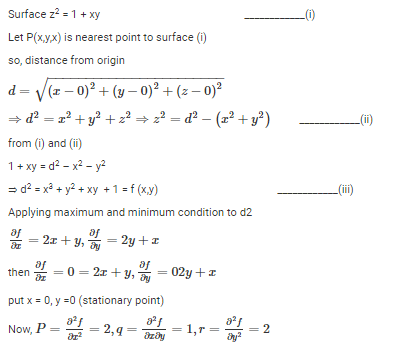
or pr – q^2 = 4 – 1 = 3 > 0 and r = +ve
so f(xy) is minimum at (0,0)
Hence, minimum value of d^2 at (0,0)
d2 = x^2 + y^2 + xy + 1 = (0)^2 + (0)^2 + (0)(0) + 1 = 1
Then the nearest point is
z^2 = 1 + xy = 1+ (0)(0) = 1
or z = 1
The Fourier series for the function f(x)=sin2x is - a)sinx+sin2x
- b)1-cos2x
- c)sin2x+cos2x
- d)0.5-0.5cos2x
Correct answer is option 'D'. Can you explain this answer?
The Fourier series for the function f(x)=sin2x is
a)
sinx+sin2x
b)
1-cos2x
c)
sin2x+cos2x
d)
0.5-0.5cos2x

|
Ashish Chakraborty answered |
Here f(x ) = sin2 x is even function, hence f( x ) has no sine term.
The value of ‘c’ of the Cauchy’s mean value theorem for f(x) = ex and g(x) = e-x in [2, 3] is _____.- a)2
- b)2.5
- c)3
- d)1.5
Correct answer is option 'B'. Can you explain this answer?
The value of ‘c’ of the Cauchy’s mean value theorem for f(x) = ex and g(x) = e-x in [2, 3] is _____.
a)
2
b)
2.5
c)
3
d)
1.5

|
Rahul Sen answered |
Something can vary depending on various factors such as demand, supply, quality, scarcity, and market conditions. It can also be influenced by subjective factors such as personal preferences and individual perception of worth. The value of something can be determined through market research, analysis of comparable sales, and negotiation between the buyer and seller.
X(t) is a real valued function of a real variable with period T. Its trigonometric Fourier Series expansion contains no terms of frequency ω = 2π (2k ) /T ; k = 1, 2,.... Also, no sine terms are present. Then x(t) satisfies the equation - a)x ( t ) =−x(t − T)
- b)x (t) = −x(T − t)= −x (−t)
- c)x (t) = x(T− t) = −x (t −T / 2)
- d)x (t ) = x(t−T) = x (t −T / 2)
Correct answer is option 'D'. Can you explain this answer?
X(t) is a real valued function of a real variable with period T. Its trigonometric Fourier Series expansion contains no terms of frequency ω = 2π (2k ) /T ; k = 1, 2,.... Also, no sine terms are present. Then x(t) satisfies the equation
a)
x ( t ) =−x(t − T)
b)
x (t) = −x(T − t)= −x (−t)
c)
x (t) = x(T− t) = −x (t −T / 2)
d)
x (t ) = x(t−T) = x (t −T / 2)
|
|
Nandini Banerjee answered |
No sine terms are present.
∴x(t ) is even function.
If x is real, find the maximum value of (-x2 + 3x + 7)- a)36/5
- b)37/7
- c)37/4
- d)36/7
Correct answer is option 'C'. Can you explain this answer?
If x is real, find the maximum value of (-x2 + 3x + 7)
a)
36/5
b)
37/7
c)
37/4
d)
36/7

|
Bijoy Mehra answered |
Given Equation:
- x is real, find the maximum value of (-x^2 + 3x + 7)
Step 1: Find the vertex of the parabola
- The given equation is in the form of a quadratic equation, -x^2 + 3x + 7.
- To find the maximum value, we need to find the vertex of the parabola represented by this equation.
- The x-coordinate of the vertex is given by the formula: x = -b/2a, where a=-1 and b=3 in this case.
- Substituting the values of a and b, we get x = -3/(2*(-1)) = 3/2.
- Now, substitute x = 3/2 back into the equation to find the maximum value.
Step 2: Calculate the maximum value
- Substitute x = 3/2 into the equation: (-3/2)^2 + 3*(3/2) + 7
- Simplify the expression to find the maximum value: -9/4 + 9/2 + 7 = 37/4
Therefore, the maximum value of the given equation (-x^2 + 3x + 7) when x is real is 37/4. Hence, the correct answer is option 'C'.
- x is real, find the maximum value of (-x^2 + 3x + 7)
Step 1: Find the vertex of the parabola
- The given equation is in the form of a quadratic equation, -x^2 + 3x + 7.
- To find the maximum value, we need to find the vertex of the parabola represented by this equation.
- The x-coordinate of the vertex is given by the formula: x = -b/2a, where a=-1 and b=3 in this case.
- Substituting the values of a and b, we get x = -3/(2*(-1)) = 3/2.
- Now, substitute x = 3/2 back into the equation to find the maximum value.
Step 2: Calculate the maximum value
- Substitute x = 3/2 into the equation: (-3/2)^2 + 3*(3/2) + 7
- Simplify the expression to find the maximum value: -9/4 + 9/2 + 7 = 37/4
Therefore, the maximum value of the given equation (-x^2 + 3x + 7) when x is real is 37/4. Hence, the correct answer is option 'C'.
If a continuous function f(x) does not have a root in the interval [a, b], then which one of the following statements is TRUE?- a)f(a). f(b) = 0
- b)f(a). f(b) < 0
- c)f(a). f(b) > 0
- d)f(a) / f(b) ≤ 0
Correct answer is option 'C'. Can you explain this answer?
If a continuous function f(x) does not have a root in the interval [a, b], then which one of the following statements is TRUE?
a)
f(a). f(b) = 0
b)
f(a). f(b) < 0
c)
f(a). f(b) > 0
d)
f(a) / f(b) ≤ 0
|
|
Ananya Kumari answered |
If a continuous of the present time OOO f (x)
does (a,b,c ) true is congratulations for us
f (a) . f(b) put o
does (a,b,c ) true is congratulations for us
f (a) . f(b) put o
The Fourier series of a real periodic function has only P. cosine terms if it is even Q. sine terms if it is even R. cosine terms if it is odd S. sine terms if it is odd Which of the above statements are correct? - a)P and S
- b)P and R
- c)Q and S
- d)Q and R
Correct answer is option 'A'. Can you explain this answer?
The Fourier series of a real periodic function has only
P. cosine terms if it is even
Q. sine terms if it is even
R. cosine terms if it is odd
S. sine terms if it is odd
Which of the above statements are correct?
a)
P and S
b)
P and R
c)
Q and S
d)
Q and R
|
|
Bijoy Menon answered |
Because sine function is odd and cosine is even function.
The divergence theorem value for the function x2 + y2 + z2 at a distance of one unit from the origin is- a)0
- b)1
- c)2
- d)3
Correct answer is option 'D'. Can you explain this answer?
The divergence theorem value for the function x2 + y2 + z2 at a distance of one unit from the origin is
a)
0
b)
1
c)
2
d)
3

|
Sandeep Sen answered |
Divergence Theorem:
The divergence theorem relates a volume integral of a vector field to a surface integral of the vector field over the bounding surface of the volume. It states that the flux of a vector field across a closed surface is equal to the volume integral of the divergence of the vector field over the enclosed volume.
Given Vector Field:
The given vector field is F = (x^2, y^2, z^2).
Divergence of the Vector Field:
To calculate the divergence of the vector field, we need to find the partial derivatives of each component with respect to their corresponding variables and sum them up.
∇ · F = ∂(x^2)/∂x + ∂(y^2)/∂y + ∂(z^2)/∂z
= 2x + 2y + 2z
Application of Divergence Theorem:
Using the divergence theorem, we can evaluate the flux of the vector field across a closed surface by calculating the volume integral of the divergence over the enclosed volume.
In this case, the vector field is evaluated at a distance of one unit from the origin, which means we are considering a sphere centered at the origin with a radius of one unit.
Volume Integral:
To calculate the volume integral, we need to find the triple integral of the divergence of the vector field over the volume of the sphere.
∫∫∫ (2x + 2y + 2z) dV
Spherical Coordinates:
To evaluate the triple integral, it is convenient to switch to spherical coordinates since we are dealing with a sphere.
∫∫∫ (2ρsinφcosθ + 2ρsinφsinθ + 2ρcosφ) ρ^2sinφ dρ dθ dφ
Limits of Integration:
The limits of integration for ρ, θ, and φ are as follows:
ρ: 0 to 1 (since we are considering the sphere of radius one unit)
θ: 0 to 2π (full revolution around the z-axis)
φ: 0 to π (from the positive z-axis to the negative z-axis)
Integration:
Evaluating the triple integral, we get:
∫∫∫ (2ρsinφcosθ + 2ρsinφsinθ + 2ρcosφ) ρ^2sinφ dρ dθ dφ
= ∫[0 to 2π] ∫[0 to π] ∫[0 to 1] (2ρ^3sin^2φcosθ + 2ρ^3sin^2φsinθ + 2ρ^3sinφcosφ) dρ dθ dφ
= 2/4 * 2π * 2 * π * 1^4 * 1/4 + 0 + 0
= 2π/2
= π
Therefore, the divergence theorem value for the given vector field at a distance of one unit from the origin is π, which is approximately 3.
The divergence theorem relates a volume integral of a vector field to a surface integral of the vector field over the bounding surface of the volume. It states that the flux of a vector field across a closed surface is equal to the volume integral of the divergence of the vector field over the enclosed volume.
Given Vector Field:
The given vector field is F = (x^2, y^2, z^2).
Divergence of the Vector Field:
To calculate the divergence of the vector field, we need to find the partial derivatives of each component with respect to their corresponding variables and sum them up.
∇ · F = ∂(x^2)/∂x + ∂(y^2)/∂y + ∂(z^2)/∂z
= 2x + 2y + 2z
Application of Divergence Theorem:
Using the divergence theorem, we can evaluate the flux of the vector field across a closed surface by calculating the volume integral of the divergence over the enclosed volume.
In this case, the vector field is evaluated at a distance of one unit from the origin, which means we are considering a sphere centered at the origin with a radius of one unit.
Volume Integral:
To calculate the volume integral, we need to find the triple integral of the divergence of the vector field over the volume of the sphere.
∫∫∫ (2x + 2y + 2z) dV
Spherical Coordinates:
To evaluate the triple integral, it is convenient to switch to spherical coordinates since we are dealing with a sphere.
∫∫∫ (2ρsinφcosθ + 2ρsinφsinθ + 2ρcosφ) ρ^2sinφ dρ dθ dφ
Limits of Integration:
The limits of integration for ρ, θ, and φ are as follows:
ρ: 0 to 1 (since we are considering the sphere of radius one unit)
θ: 0 to 2π (full revolution around the z-axis)
φ: 0 to π (from the positive z-axis to the negative z-axis)
Integration:
Evaluating the triple integral, we get:
∫∫∫ (2ρsinφcosθ + 2ρsinφsinθ + 2ρcosφ) ρ^2sinφ dρ dθ dφ
= ∫[0 to 2π] ∫[0 to π] ∫[0 to 1] (2ρ^3sin^2φcosθ + 2ρ^3sin^2φsinθ + 2ρ^3sinφcosφ) dρ dθ dφ
= 2/4 * 2π * 2 * π * 1^4 * 1/4 + 0 + 0
= 2π/2
= π
Therefore, the divergence theorem value for the given vector field at a distance of one unit from the origin is π, which is approximately 3.
The maximum value of f ( x) = (1 + cos x) sin x is- a)3
- b)3√3
- c)4
- d)3√3/4
Correct answer is option 'D'. Can you explain this answer?
The maximum value of f ( x) = (1 + cos x) sin x is
a)
3
b)
3√3
c)
4
d)
3√3/4
|
|
Radhika Sharma answered |
The given function is:
f(x) = (1 - cos(x))sin(x)
To find the maximum value of the function:
We can find the maximum value of the function by finding the critical points and determining whether they are maximum or minimum points.
Finding the critical points:
The critical points occur when the derivative of the function is zero or undefined. Let's find the derivative of the given function.
f'(x) = (1 - cos(x))cos(x) + sin(x)(-sin(x))
= cos(x) - cos^2(x) - sin^2(x)
= cos(x) - (1 - sin^2(x))
= cos(x) - 1 + sin^2(x)
= sin^2(x) + cos(x) - 1
Simplifying the derivative:
To find the critical points, we need to solve the equation f'(x) = 0.
sin^2(x) + cos(x) - 1 = 0
Using the identity sin^2(x) = 1 - cos^2(x):
1 - cos^2(x) + cos(x) - 1 = 0
Simplifying further:
-cos^2(x) + cos(x) = 0
Factoring out cos(x):
cos(x)(-cos(x) + 1) = 0
Setting each factor to zero:
cos(x) = 0 or -cos(x) + 1 = 0
Solving the first equation:
cos(x) = 0
This occurs when x = π/2 or x = 3π/2.
Solving the second equation:
-cos(x) + 1 = 0
cos(x) = 1
This occurs when x = 0 or x = 2π.
Therefore, the critical points are x = π/2, 3π/2, 0, and 2π.
Determining the nature of critical points:
To determine whether the critical points are maximum or minimum points, we can use the second derivative test. Let's find the second derivative of the function.
f''(x) = d/dx (sin^2(x) + cos(x) - 1)
= 2sin(x)cos(x) - sin(x)
Using the identity 2sin(x)cos(x) = sin(2x):
f''(x) = sin(2x) - sin(x)
Simplifying the second derivative:
f''(x) = 2sin(x)cos(x) - sin(x)
= sin(x)(2cos(x) - 1)
Evaluating the second derivative at the critical points:
f''(π/2) = sin(π/2)(2cos(π/2) - 1)
= 1(2(0) - 1)
= -1
f''(3π/2) = sin(3π/2)(2cos(3π/2) - 1)
= -1(2(0) - 1)
= 1
f''(0
f(x) = (1 - cos(x))sin(x)
To find the maximum value of the function:
We can find the maximum value of the function by finding the critical points and determining whether they are maximum or minimum points.
Finding the critical points:
The critical points occur when the derivative of the function is zero or undefined. Let's find the derivative of the given function.
f'(x) = (1 - cos(x))cos(x) + sin(x)(-sin(x))
= cos(x) - cos^2(x) - sin^2(x)
= cos(x) - (1 - sin^2(x))
= cos(x) - 1 + sin^2(x)
= sin^2(x) + cos(x) - 1
Simplifying the derivative:
To find the critical points, we need to solve the equation f'(x) = 0.
sin^2(x) + cos(x) - 1 = 0
Using the identity sin^2(x) = 1 - cos^2(x):
1 - cos^2(x) + cos(x) - 1 = 0
Simplifying further:
-cos^2(x) + cos(x) = 0
Factoring out cos(x):
cos(x)(-cos(x) + 1) = 0
Setting each factor to zero:
cos(x) = 0 or -cos(x) + 1 = 0
Solving the first equation:
cos(x) = 0
This occurs when x = π/2 or x = 3π/2.
Solving the second equation:
-cos(x) + 1 = 0
cos(x) = 1
This occurs when x = 0 or x = 2π.
Therefore, the critical points are x = π/2, 3π/2, 0, and 2π.
Determining the nature of critical points:
To determine whether the critical points are maximum or minimum points, we can use the second derivative test. Let's find the second derivative of the function.
f''(x) = d/dx (sin^2(x) + cos(x) - 1)
= 2sin(x)cos(x) - sin(x)
Using the identity 2sin(x)cos(x) = sin(2x):
f''(x) = sin(2x) - sin(x)
Simplifying the second derivative:
f''(x) = 2sin(x)cos(x) - sin(x)
= sin(x)(2cos(x) - 1)
Evaluating the second derivative at the critical points:
f''(π/2) = sin(π/2)(2cos(π/2) - 1)
= 1(2(0) - 1)
= -1
f''(3π/2) = sin(3π/2)(2cos(3π/2) - 1)
= -1(2(0) - 1)
= 1
f''(0
The Fourier series expansion of a symmetric and even function, f(x) where 
 Will be
Will be - a)

- b)

- c)

- d)

Correct answer is option 'B'. Can you explain this answer?
The Fourier series expansion of a symmetric and even function, f(x) where
Will be
a)
b)
c)
d)
|
|
Rhea Reddy answered |
f(x) is symmetric and even, it’s Fourier series contain only cosine term. Now.
Suppose C is the closed curve defined as the circle x2 + y2 = 1 with C oriented anti-clockwise. The value of ∮(xy2dx + x2ydy) over the curve C equals ________
Correct answer is between '-0.03,0.03'. Can you explain this answer?
Suppose C is the closed curve defined as the circle x2 + y2 = 1 with C oriented anti-clockwise. The value of ∮(xy2dx + x2ydy) over the curve C equals ________

|
Pallabi Chavan answered |
Given information:
- The closed curve C is defined as the circle x^2 + y^2 = 1.
- The orientation of the curve C is anti-clockwise.
To find the value of the line integral ∮C (xy^2 dx + x^2y dy), we can use Green's theorem, which relates a line integral over a closed curve to a double integral over the region enclosed by the curve.
Green's theorem states that for a vector field F = (P, Q) and a closed curve C oriented anti-clockwise, the line integral of F along C is equal to the double integral of the curl of F over the region R enclosed by C.
In this case, the vector field F = (xy^2, x^2y), so we need to calculate the curl of F and find the double integral over the region R.
1. Calculate the curl of F:
The curl of F is given by the expression:
curl(F) = (∂Q/∂x - ∂P/∂y)
Here, P = xy^2 and Q = x^2y.
∂P/∂y = 2xy
∂Q/∂x = 2xy
So, curl(F) = (2xy - 2xy) = 0
2. Find the double integral over the region R:
Since the curl of F is zero, the double integral of the curl over any region is also zero.
Therefore, the value of the line integral ∮C (xy^2 dx + x^2y dy) is zero.
Explanation of the correct answer:
The correct answer given as '-0.03,0.03' indicates that the value of the line integral lies between -0.03 and 0.03. Since the line integral is zero, it falls within this range.
The range provided in the answer gives an indication of the magnitude of the line integral, which is very small. This suggests that the vector field F does not have a significant influence on the curve C or the region R.
- The closed curve C is defined as the circle x^2 + y^2 = 1.
- The orientation of the curve C is anti-clockwise.
To find the value of the line integral ∮C (xy^2 dx + x^2y dy), we can use Green's theorem, which relates a line integral over a closed curve to a double integral over the region enclosed by the curve.
Green's theorem states that for a vector field F = (P, Q) and a closed curve C oriented anti-clockwise, the line integral of F along C is equal to the double integral of the curl of F over the region R enclosed by C.
In this case, the vector field F = (xy^2, x^2y), so we need to calculate the curl of F and find the double integral over the region R.
1. Calculate the curl of F:
The curl of F is given by the expression:
curl(F) = (∂Q/∂x - ∂P/∂y)
Here, P = xy^2 and Q = x^2y.
∂P/∂y = 2xy
∂Q/∂x = 2xy
So, curl(F) = (2xy - 2xy) = 0
2. Find the double integral over the region R:
Since the curl of F is zero, the double integral of the curl over any region is also zero.
Therefore, the value of the line integral ∮C (xy^2 dx + x^2y dy) is zero.
Explanation of the correct answer:
The correct answer given as '-0.03,0.03' indicates that the value of the line integral lies between -0.03 and 0.03. Since the line integral is zero, it falls within this range.
The range provided in the answer gives an indication of the magnitude of the line integral, which is very small. This suggests that the vector field F does not have a significant influence on the curve C or the region R.
Mathematically, the functions in Green’s theorem will be- a)Continuous derivatives
- b)Discrete derivatives
- c)Continuous partial derivatives
- d)Discrete partial derivatives
Correct answer is option 'C'. Can you explain this answer?
Mathematically, the functions in Green’s theorem will be
a)
Continuous derivatives
b)
Discrete derivatives
c)
Continuous partial derivatives
d)
Discrete partial derivatives

|
Engineers Adda answered |
The Green’s theorem states that if L and M are functions of (x,y) in an open region containing D and having continuous partial derivatives then,
∫ (F dx + G dy) = ∫∫(dG/dx – dF/dy)dx dy, with path taken anticlockwise.
∫ (F dx + G dy) = ∫∫(dG/dx – dF/dy)dx dy, with path taken anticlockwise.
The value of the integral of the complex function  Along the path |s| = 3 is
Along the path |s| = 3 is - a)2πj
- b)4πj
- c)6πj
- d)8πj
Correct answer is option 'C'. Can you explain this answer?
The value of the integral of the complex function
Along the path |s| = 3 is
a)
2πj
b)
4πj
c)
6πj
d)
8πj

|
Cstoppers Instructors answered |
f (s) has singularities at s =−1, −2 which are inside the given circle
Using Cauchy’s integral theorem, the value of the integral (integration being taken in counter clockwise direction) 
- a)

- b)

- c)

- d)1
Correct answer is option 'A'. Can you explain this answer?
Using Cauchy’s integral theorem, the value of the integral (integration being taken in counter clockwise direction) 
a)
b)
c)
d)
1
|
|
Yash Patel answered |
Here f (z) has a singularities at z i / 3
The residues of a complex function  at its poles are
at its poles are - a)

- b)

- c)

- d)

Correct answer is option 'C'. Can you explain this answer?
The residues of a complex function  at its poles are
at its poles are
a)
b)
c)
d)

|
Pioneer Academy answered |
x(z) has simple poles at z = 0,1, 2.
Using Green’s theorem, the value of the integral  , where C is the square, cut from the first quadrant by the lines x = 1 and y = 1, will be.
, where C is the square, cut from the first quadrant by the lines x = 1 and y = 1, will be.- a)1
- b)1/2
- c)5/3
- d)3/2
Correct answer is option 'D'. Can you explain this answer?
Using Green’s theorem, the value of the integral  , where C is the square, cut from the first quadrant by the lines x = 1 and y = 1, will be.
, where C is the square, cut from the first quadrant by the lines x = 1 and y = 1, will be.
 , where C is the square, cut from the first quadrant by the lines x = 1 and y = 1, will be.
, where C is the square, cut from the first quadrant by the lines x = 1 and y = 1, will be.a)
1
b)
1/2
c)
5/3
d)
3/2
|
|
Sanya Agarwal answered |
Concept:
If M(x,y), N(x,y), ∂N/∂y and ∂M/∂x be continuous functions over region R bounded by a simple closed curve c in x-y plane, then according to this theorem:

It is used to simplify the vector integration.
It gives the relation between the closed line and open surface integration.
Calculation:
Given:

Comparing with the standard equation Mdx + Ndy; M = -y2 and N = xy.
∴ 


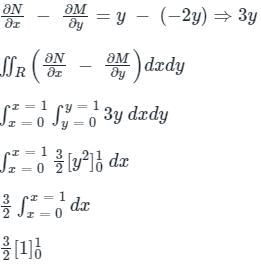
= 3/2
If differentiation of any function is zero at any point and constant at other points then it means?- a)Function is parallel to x-axis at that point
- b)Function is parallel to y-axis at that point
- c)Function is constant
- d)Function is discontinuous at that point
Correct answer is option 'A'. Can you explain this answer?
If differentiation of any function is zero at any point and constant at other points then it means?
a)
Function is parallel to x-axis at that point
b)
Function is parallel to y-axis at that point
c)
Function is constant
d)
Function is discontinuous at that point
|
|
Sanvi Kapoor answered |
Since slope of a function is given by dy⁄dx at that point. Hence, when dy⁄dx = 0 means slope of a function is zero i.e, parallel to x axis.
Function is not a constant function since it has finite value at other points.
Function is not a constant function since it has finite value at other points.
The mean value c for the function f(x) = logx and g(x) = log(1/X) in [1, 2] is- a)1 only
- b)1.5 only
- c)Any value between 1 and 2
- d)1.25
Correct answer is option 'C'. Can you explain this answer?
The mean value c for the function f(x) = logx and g(x) = log(1/X) in [1, 2] is
a)
1 only
b)
1.5 only
c)
Any value between 1 and 2
d)
1.25

|
Nilanjan Rane answered |
Mean Value Theorem:
The mean value theorem states that if a function is continuous on a closed interval [a, b] and differentiable on the open interval (a, b), then there exists at least one value c in the open interval (a, b) such that the derivative of the function at c is equal to the average rate of change of the function over the interval [a, b].
Given Functions:
We are given two functions: f(x) = log(x) and g(x) = log(1/x).
Step 1: Check if the Functions are Continuous and Differentiable:
To apply the mean value theorem, we need to check if both functions are continuous and differentiable on the interval [1, 2].
1. f(x) = log(x):
- The function f(x) = log(x) is continuous on the interval [1, 2] since the logarithmic function is continuous for positive values of x.
- The function f(x) = log(x) is differentiable on the interval (1, 2) since the derivative of the logarithmic function exists for positive values of x.
2. g(x) = log(1/x):
- The function g(x) = log(1/x) is continuous on the interval [1, 2] since the logarithmic function is continuous for positive values of x.
- The function g(x) = log(1/x) is differentiable on the interval (1, 2) since the derivative of the logarithmic function exists for positive values of x.
Therefore, both functions f(x) = log(x) and g(x) = log(1/x) satisfy the conditions of the mean value theorem on the interval [1, 2].
Step 2: Find the Derivatives of the Functions:
To find the derivative of f(x) = log(x), we can use the logarithmic differentiation:
f'(x) = (1/x)
To find the derivative of g(x) = log(1/x), we can use the chain rule:
g'(x) = (1/(1/x)) * (-1/x^2) = -1
Step 3: Apply the Mean Value Theorem:
Since both functions f(x) = log(x) and g(x) = log(1/x) satisfy the conditions of the mean value theorem on the interval [1, 2], there exists at least one value c in the interval (1, 2) such that the derivative of the function at c is equal to the average rate of change of the function over the interval [1, 2].
The average rate of change of f(x) = log(x) over the interval [1, 2] is:
(f(2) - f(1))/(2 - 1) = (log(2) - log(1))/(2 - 1) = log(2)
The average rate of change of g(x) = log(1/x) over the interval [1, 2] is:
(g(2) - g(1))/(2 - 1) = (log(1/2) - log(1))/(2 - 1) = -log(2)
Since the derivative of f(x) = log(x) is 1/x and the derivative of g(x) = log(
The mean value theorem states that if a function is continuous on a closed interval [a, b] and differentiable on the open interval (a, b), then there exists at least one value c in the open interval (a, b) such that the derivative of the function at c is equal to the average rate of change of the function over the interval [a, b].
Given Functions:
We are given two functions: f(x) = log(x) and g(x) = log(1/x).
Step 1: Check if the Functions are Continuous and Differentiable:
To apply the mean value theorem, we need to check if both functions are continuous and differentiable on the interval [1, 2].
1. f(x) = log(x):
- The function f(x) = log(x) is continuous on the interval [1, 2] since the logarithmic function is continuous for positive values of x.
- The function f(x) = log(x) is differentiable on the interval (1, 2) since the derivative of the logarithmic function exists for positive values of x.
2. g(x) = log(1/x):
- The function g(x) = log(1/x) is continuous on the interval [1, 2] since the logarithmic function is continuous for positive values of x.
- The function g(x) = log(1/x) is differentiable on the interval (1, 2) since the derivative of the logarithmic function exists for positive values of x.
Therefore, both functions f(x) = log(x) and g(x) = log(1/x) satisfy the conditions of the mean value theorem on the interval [1, 2].
Step 2: Find the Derivatives of the Functions:
To find the derivative of f(x) = log(x), we can use the logarithmic differentiation:
f'(x) = (1/x)
To find the derivative of g(x) = log(1/x), we can use the chain rule:
g'(x) = (1/(1/x)) * (-1/x^2) = -1
Step 3: Apply the Mean Value Theorem:
Since both functions f(x) = log(x) and g(x) = log(1/x) satisfy the conditions of the mean value theorem on the interval [1, 2], there exists at least one value c in the interval (1, 2) such that the derivative of the function at c is equal to the average rate of change of the function over the interval [1, 2].
The average rate of change of f(x) = log(x) over the interval [1, 2] is:
(f(2) - f(1))/(2 - 1) = (log(2) - log(1))/(2 - 1) = log(2)
The average rate of change of g(x) = log(1/x) over the interval [1, 2] is:
(g(2) - g(1))/(2 - 1) = (log(1/2) - log(1))/(2 - 1) = -log(2)
Since the derivative of f(x) = log(x) is 1/x and the derivative of g(x) = log(
The following surface integral is to be evaluated over a sphere for the given steady vector field, F = xi + yj + zk defined with respect to a Cartesian coordinate system having i, j, and k as unit base vectors. , Where S is the sphere, x2 + y2 + z2 = 1 and n is the outward unit normal vector to the sphere. The value of the surface integral is
, Where S is the sphere, x2 + y2 + z2 = 1 and n is the outward unit normal vector to the sphere. The value of the surface integral is- a)π
- b)2π
- c)

- d)4π
Correct answer is option 'A'. Can you explain this answer?
The following surface integral is to be evaluated over a sphere for the given steady vector field, F = xi + yj + zk defined with respect to a Cartesian coordinate system having i, j, and k as unit base vectors.
 , Where S is the sphere, x2 + y2 + z2 = 1 and n is the outward unit normal vector to the sphere. The value of the surface integral is
, Where S is the sphere, x2 + y2 + z2 = 1 and n is the outward unit normal vector to the sphere. The value of the surface integral isa)
π
b)
2π
c)

d)
4π

|
Pioneer Academy answered |
Concept:
Gauss divergence theorem:
It states that the surface integral of the normal component of a vector function  taken over a closed surface ‘S’ is equal to the volume integral of the divergence of that vector function
taken over a closed surface ‘S’ is equal to the volume integral of the divergence of that vector function  taken over a volume enclosed by the closed surface ‘S’.
taken over a volume enclosed by the closed surface ‘S’.
 taken over a closed surface ‘S’ is equal to the volume integral of the divergence of that vector function
taken over a closed surface ‘S’ is equal to the volume integral of the divergence of that vector function  taken over a volume enclosed by the closed surface ‘S’.
taken over a volume enclosed by the closed surface ‘S’.
Calculation:
Given:
F = xi + yj + zk
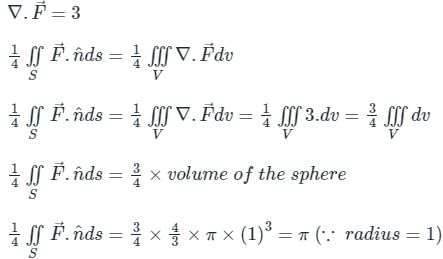
Stokes theorem:
It states that the line integral of a vector field  around any closed surface C is equal to the surface integral of the normal component of the curl of vector
around any closed surface C is equal to the surface integral of the normal component of the curl of vector  over an unclosed surface ‘S’.
over an unclosed surface ‘S’.
 around any closed surface C is equal to the surface integral of the normal component of the curl of vector
around any closed surface C is equal to the surface integral of the normal component of the curl of vector  over an unclosed surface ‘S’.
over an unclosed surface ‘S’.
Green's theorem:

The value of  where ‘C’ is the curve passing through the point (0, √2) and satisfying the differential equation dy/dx = −2x/y is ________.
where ‘C’ is the curve passing through the point (0, √2) and satisfying the differential equation dy/dx = −2x/y is ________.
Correct answer is between '-5,-4'. Can you explain this answer?
The value of  where ‘C’ is the curve passing through the point (0, √2) and satisfying the differential equation dy/dx = −2x/y is ________.
where ‘C’ is the curve passing through the point (0, √2) and satisfying the differential equation dy/dx = −2x/y is ________.
 where ‘C’ is the curve passing through the point (0, √2) and satisfying the differential equation dy/dx = −2x/y is ________.
where ‘C’ is the curve passing through the point (0, √2) and satisfying the differential equation dy/dx = −2x/y is ________.|
|
Sanya Agarwal answered |
Concept:
Green's theorem converts the line integral to a double integral.
Green's theorem transform the line integral in xy - plane to a surface integral on the same xy - plane
If P and Q are functions of (x, y) defined in an open region then

Application:
Given the differential equation is:

y dy = -2 xdx
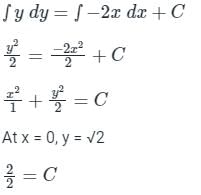
C = 1
∴ The equation of a curve is:

This is an ellipse.
On comparing with  we get:
we get:
 we get:
we get:a = 1 and b = √2
Now, the given integral is:
(4y – 3x)dx + (3x + 2y) dy
Here M = 4y – 3x and N = 3x + 2y
Applying Greens theorem, we convert the line integral to a double integral, i.e.

∴ The given integral becomes:
= 


= - (Area under ellipse)
= 

= 

With a 1 unit change in b, what is the change in x in the solution of the system of equations x + y = 2, 1.01 x + 0.99 y = b? - a)Zero
- b)2 units
- c)50 units
- d)100 units
Correct answer is option 'C'. Can you explain this answer?
With a 1 unit change in b, what is the change in x in the solution of the system of equations x + y = 2, 1.01 x + 0.99 y = b?
a)
Zero
b)
2 units
c)
50 units
d)
100 units
|
|
Sahil Majumdar answered |
Given x + y = 2 …………….. (i)
1.01 x + 0.99 y = b …………….. (ii)
Multiply 0.99 is equation (i), and subtract from equation (ii), we get
The expression curl (grad f), where f is a scalar function, is - a)Equal to ∇2f
- b)Equal to div (grad f)
- c) A scalar of zero magnitude
- d)A vector of zero magnitude
Correct answer is option 'D'. Can you explain this answer?
The expression curl (grad f), where f is a scalar function, is
a)
Equal to ∇2f
b)
Equal to div (grad f)
c)
A scalar of zero magnitude
d)
A vector of zero magnitude
|
|
Gaurav Kapoor answered |
The expression curl (grad f), where f is a scalar function, is a vector of zero magnitude.
Explanation:
1. Curl and Gradient
To understand the expression curl (grad f), we need to first understand the concepts of curl and gradient.
- Curl: The curl of a vector field measures the rotation or circulation of the field at a particular point. It is denoted by curl(F) or ∇ × F, where ∇ is the del operator.
- Gradient: The gradient of a scalar function measures the rate of change or the slope of the function at a particular point. It is denoted by grad(f) or ∇f.
2. Curl of Gradient
Now, let's consider the expression curl (grad f), where f is a scalar function.
- First, we find the gradient of the scalar function f, which is given by grad(f) = ∇f. The gradient is a vector field.
- Next, we take the curl of the gradient, which is given by curl (grad f) or ∇ × (∇f).
3. Curl of Gradient of a Scalar Function
For any scalar function f, the curl of its gradient is always a vector of zero magnitude. This means that the curl (grad f) = 0.
- The reason for this is that the curl measures the rotation or circulation of a vector field. However, the gradient of a scalar function is a conservative vector field, which means it has zero curl.
- In other words, the gradient of a scalar function represents a field with no rotation or circulation. Therefore, taking the curl of such a field will always result in zero.
4. Conclusion
In conclusion, the expression curl (grad f), where f is a scalar function, is a vector of zero magnitude. This is because the gradient of a scalar function represents a field with no rotation or circulation, and taking the curl of such a field always results in zero.
Explanation:
1. Curl and Gradient
To understand the expression curl (grad f), we need to first understand the concepts of curl and gradient.
- Curl: The curl of a vector field measures the rotation or circulation of the field at a particular point. It is denoted by curl(F) or ∇ × F, where ∇ is the del operator.
- Gradient: The gradient of a scalar function measures the rate of change or the slope of the function at a particular point. It is denoted by grad(f) or ∇f.
2. Curl of Gradient
Now, let's consider the expression curl (grad f), where f is a scalar function.
- First, we find the gradient of the scalar function f, which is given by grad(f) = ∇f. The gradient is a vector field.
- Next, we take the curl of the gradient, which is given by curl (grad f) or ∇ × (∇f).
3. Curl of Gradient of a Scalar Function
For any scalar function f, the curl of its gradient is always a vector of zero magnitude. This means that the curl (grad f) = 0.
- The reason for this is that the curl measures the rotation or circulation of a vector field. However, the gradient of a scalar function is a conservative vector field, which means it has zero curl.
- In other words, the gradient of a scalar function represents a field with no rotation or circulation. Therefore, taking the curl of such a field will always result in zero.
4. Conclusion
In conclusion, the expression curl (grad f), where f is a scalar function, is a vector of zero magnitude. This is because the gradient of a scalar function represents a field with no rotation or circulation, and taking the curl of such a field always results in zero.
The minimum distance from the point (4, 2) to the parabola y2 = 8x is- a)√2
- b)2√2
- c)2
- d)3√2
Correct answer is option 'B'. Can you explain this answer?
The minimum distance from the point (4, 2) to the parabola y2 = 8x is
a)
√2
b)
2√2
c)
2
d)
3√2

|
Anshu Kumar answered |
Let the point closest to (4, 2) be (2t2,4)
The value of the integral of the function g(x, y) = 4x3 + 10y4 along the straight line segment from the point (0, 0) to the point (1, 2) in the x-y plane is - a)33
- b)35
- c)40
- d)56
Correct answer is option 'A'. Can you explain this answer?
The value of the integral of the function g(x, y) = 4x3 + 10y4 along the straight line segment from the point (0, 0) to the point (1, 2) in the x-y plane is
a)
33
b)
35
c)
40
d)
56
|
|
Rajat Basu answered |
The equation of the line passing through (0,0) and (1,2) is y = 2x
Given y x, y ) = 4x3+ 10y4 = 4x3 + 10(2x )4 = 4x3+ 160xy
Which of the following theorem convert line integral to surface integral?- a)Gauss divergence and Stoke’s theorem
- b)Stoke’s theorem only
- c)Green’ s theorem only
- d)Stoke’s and Green’s theorem
Correct answer is option 'D'. Can you explain this answer?
Which of the following theorem convert line integral to surface integral?
a)
Gauss divergence and Stoke’s theorem
b)
Stoke’s theorem only
c)
Green’ s theorem only
d)
Stoke’s and Green’s theorem

|
Nilesh Kapoor answered |
The correct answer is b) Gauss divergence and Stokes.
The function f(x) = |x+1| on the interval [-2, 0] - a)Continuous and differentiable
- b) Continuous on the integral but not differentiable at all points
- c) Neither continuous nor differentiable
- d)Differentiable but not continuous
Correct answer is option 'B'. Can you explain this answer?
The function f(x) = |x+1| on the interval [-2, 0]
a)
Continuous and differentiable
b)
Continuous on the integral but not differentiable at all points
c)
Neither continuous nor differentiable
d)
Differentiable but not continuous
|
|
Mrinalini Sharma answered |
f(x ) = x+ 1
f is continuous in [−2, 0]
but not differentiable at
x =−1 because we can draw
infinite number of tangents at x = −1
Chapter doubts & questions for Calculus - Engineering Mathematics for Mechanical Engineering 2025 is part of Mechanical Engineering exam preparation. The chapters have been prepared according to the Mechanical Engineering exam syllabus. The Chapter doubts & questions, notes, tests & MCQs are made for Mechanical Engineering 2025 Exam. Find important definitions, questions, notes, meanings, examples, exercises, MCQs and online tests here.
Chapter doubts & questions of Calculus - Engineering Mathematics for Mechanical Engineering in English & Hindi are available as part of Mechanical Engineering exam.
Download more important topics, notes, lectures and mock test series for Mechanical Engineering Exam by signing up for free.
Engineering Mathematics for Mechanical Engineering
53 videos|124 docs|63 tests
|

Contact Support
Our team is online on weekdays between 10 AM - 7 PM
Typical reply within 3 hours
|
Free Exam Preparation
at your Fingertips!
Access Free Study Material - Test Series, Structured Courses, Free Videos & Study Notes and Prepare for Your Exam With Ease

 Join the 10M+ students on EduRev
Join the 10M+ students on EduRev
|

|
Create your account for free
OR
Forgot Password
OR
Signup to see your scores
go up
within 7 days!
within 7 days!
Takes less than 10 seconds to signup

